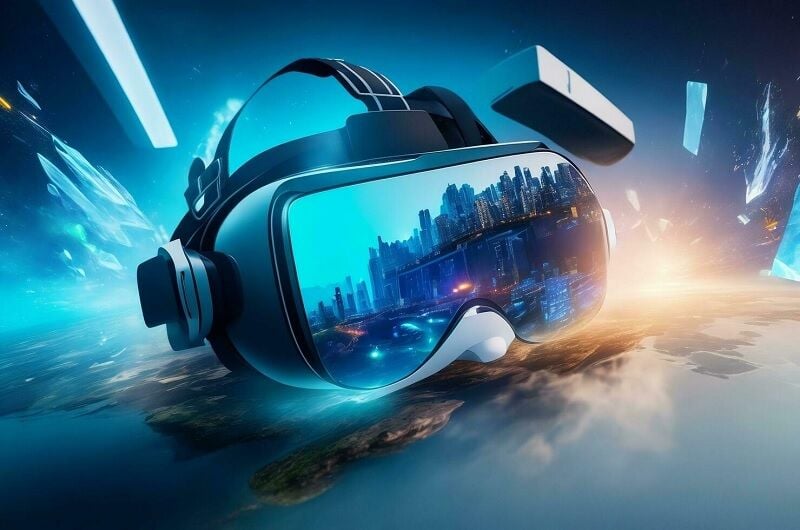The rise of augmented reality and virtual reality

As the trend of working from anywhere solidifies, the complexity of re-establishing an office-like setting at home becomes increasingly conspicuous. This issue extends beyond simply acquiring ample space or sufficient privacy the inconveniences associated with transporting large-scale monitors are also noteworthy. Here, Augmented Reality (AR) and Virtual Reality (VR) emerge, offering potential solutions to these obstacles.
Envision metamorphosing your residential living space into a comprehensively prepared office with the mere use of smart glasses. This is no longer relegated to the realm of science fiction; it is the burgeoning enterprise market for smart glasses, which industry projections estimate will escalate to an impressive $128 billion by 2025. Primarily applied for training and remote aid within sectors such as healthcare and logistics, these devices are radically altering our approach to professional tasks.
However, the journey does not come without its setbacks. The substantial fiscal investment necessitated by these devices means that their Return on Investment (ROI) requires justification. Despite this, it is evident through the significant backing of industrial heavyweights like Apple that AR and VR are far from transient trends. These technologies are poised to be intrinsic components of future work scenarios.
The rise of augmented reality and virtual reality
In response to modern work challenges, innovations in Augmented Reality and Virtual Reality technologies have shown significant growth and improvement.
The evolution and growth over time
When considering the growth of AR and VR technologies, key milestone events act as markers. AR and VR were initially thought to be the realm of gaming alone; however, this belief has been ebb away significantly. Dramatic improvements mean AR and VR now find application in industries such as healthcare, logistics, and manufacturing. Technological progress has produced sophisticated, precise devices like the ThinkReality A3 smart glasses from Lenovo. Enterprises and businesses jumped on the bandwagon, observing the palpable benefits that come with the flexibility of working anywhere. In mere years, the enterprise market for smart glasses projected a potential worth of $128 billion by 2025, indicating the sheer pace of growth.
A comparative examination: salient differences and underlying similarities
The overarching classification for AR (Augmented Reality) and VR (Virtual Reality) is ‘Extended Reality (XR)’. Nevertheless, it is essential to precisely delineate their individual characteristics. Augmented Reality characteristically overlays digital constituents onto the tangible world, enabling the user to have interactive encounters with virtual objects within a physical milieu.
Evolving technological advancements continue to obscure the demarcation between AR and VR, signaling the advent of a future where XR technologies will be an intrinsic component of our routine life and professional environments. The escalating prominence of AR and VR exemplifies a robust, unwavering progression towards a symbiotic digital-natural realm.
Understanding augmented reality

Before diving deep into the rise of Augmented Reality (AR) and Virtual Reality (VR), it’s crucial to fathom how AR functions and its expansive applications across a multitude of sectors.
The functionality of augmented reality
Augmented Reality operates primarily through the superimposition of digital components onto the natural world, effectively amplifying our sensory perception. It can be described as an innovative synthesis of physicality and digital technology. Essential elements such as Global Positioning System (GPS) sensors, and gyroscopes collaborate to determine the precise location and orientation of the user. This combination of metrics provides AR applications with the capacity to adjust to the user’s situation.
In its practical application, AR significantly enhances your digital experiences. For instance, the mobile application, Pokemon Go, demonstrates this property admirably. Utilising AR, participants are able to locate and accumulate Pokemon characters that materialize in real-world locations. Further diversifying its utility, the social media platform TikTok has incorporated AR filters through its proprietary software, Effect House.
Applications across various industries
Augmented Reality (AR) is a disruptive technology, reshaping industries and changing the way we interact with the world and each other. Below are some instances of how AR applications are transforming conventional methods across several sectors.
In the realm of Education, AR-powered classrooms are redesigning traditional learning methods. Imagine a classroom transformed by the virtual presence of iconic historical figures—enhancing learning experiences in a tangible and interactive manner.
Lastly, in Healthcare, AR contributes significantly to patient care and treatment. Questions like “how does augmented reality work in healthcare” lead us to solutions that are revolutionizing patient care through interactive and innovative methods.
Exploring virtual reality

Stepping into the realm of Virtual Reality (VR), a marvellous technological innovation, brings us better insight into the expansive world of digital immersion. Not limited to just entertainment, VR has set its mark on various fields, taking user experiences to an entirely new level.
The mechanics of virtual reality
Understanding the ins and outs of VR can seem daunting, but it’s simpler than you think. First off, VR operates by overlaying a completely immersive, computer-generated environment for your senses. To achieve this, VR employs a headset, equipped with screens set right in front of your eyes. This innovative setup essentially isolates you from the physical world and catapults you into a simulated surrounding.
This digital world responds in real-time to your movements and interactions, thanks to a formidable array of sensors and input devices. Advanced VR systems even incorporate gloves or suits, laden with sensors, to further replicate physical sensations. Imagine being able to feel the virtual breeze on your skin, or grasp digital objects – VR makes it possible. One crucial requirement, however, is dedicated hardware capable of rendering these beautifully complex virtual spaces and delivering them to the user without any discernible lag.
Virtual reality in entertainment and beyond
Exploring the implications of VR, you may first think of the gaming industry. Indeed, VR gaming offers immersive experiences that are nothing short of revolutionary. However, the scope of VR extends much further than such traditional realms of entertainment.
Look at the educational field. With VR, students can now virtually visit museums and heritage sites, traverse through historical locations in stunning detail, and explore the intricacies of the universe from their classrooms − a transformative leap from relying solely on textbooks and static images.
It’s clear that VR, while still in its relatively nascent stage, is pushing boundaries across multiple sectors. As more applications of VR come to light in more spheres, it’s inevitable that they will play vital roles in the continuous digital evolution that is guiding us into the future.
Comparative analysis
In this section, we’ll delve into an in-depth comparative analysis between Augmented Reality and Virtual Reality discerning the distinctive advantages and drawbacks of each, and envisioning how their mutual evolution could shape the future of digital transformation.
Augmented reality and virtual reality benefits and drawbacks
An example of AR technology in action includes Lenovo’s ThinkReality A3 smart glasses. Able to create a personalised workspace with up to five 1080p virtual displays, these glasses embody AR’s capacity to transform any location into a confidential, efficient workspace, overcoming space limitations in physical environments.
While AR requires less equipment, thus enhancing portability and convenience, VR often requires proper setup and specific gear like sensors or joysticks. Both technologies come with their sets of pros and cons, promising divergent possibilities.
The future interplay between AR and VR
Imagine working on a design project using AR glasses to project schematics in your living room, then swiftly switching to a VR headset for a virtual client meeting. Or maybe you’re an education professional, using AR to teach students about various plant species in a park, then switching to a VR segment for an immersive trip to an ancient rainforest. The ‘Rise of Augmented Reality AR and Virtual Reality VR’ is not just about the ascension of two independent technologies, but about their symbiosis, heralding an exciting era of blended realities.
Technological impediments and advancements

The progression of AR and VR is accompanied by its unique set of obstacles and innovations. In this segment, we shall explore the technical impediments encountered in augmented reality and the latest developments in the realm of virtual reality technology.
Technical hurdles in augmented reality
Despite a promising future, Augmented Reality (AR) is not devoid of technical obstacles. Hardware limitations, for example, limit the overall performance and impact of AR technologies. AR devices must be lightweight, comfortable, and power-efficient, yet robust enough to deliver immersive experiences, a balance that proves to be a technical challenge.
Finally, privacy concerns stand among the key deterrents. Specifically, AR technologies like AR glasses must strike a balance between functionality, namely processing incoming visual data to render pertinent AR overlays and user privacy. Products like Lenovo’s ThinkReality A3 are examples of efforts to address these issues; these glasses offer an ultraportable and comfortable AR experience with up to five 1080p virtual displays, ensuring complete privacy for confidential work.
AR and VR technologies continue to evolve, they’re opening up new possibilities and experiences, signalling an exciting future for blended realities under XR. Stay tuned as we continue to track this thrilling journey.
Want to no more, How will climate change affect Thailand in the future. With its stunning variety of places, from mountains to beaches, Thailand is rolling up its sleeves to face the challenges of climate change head-on. Imagine the scene: rising sea levels and more extreme weather are set to shake things up in Thailand’s beautiful landscapes, vibrant communities, and a strong economy.
Latest Thailand News
Follow The Thaiger on Google News:


























